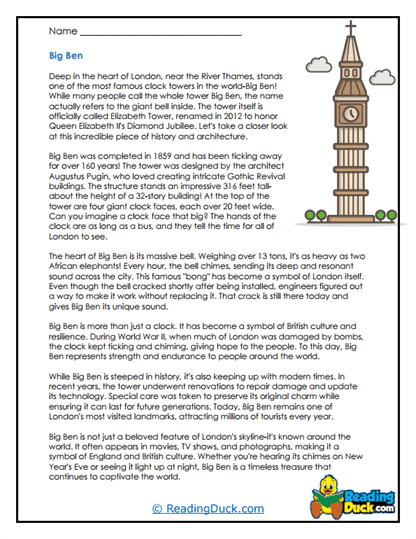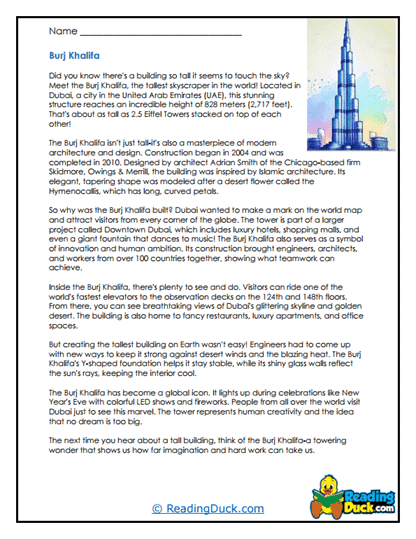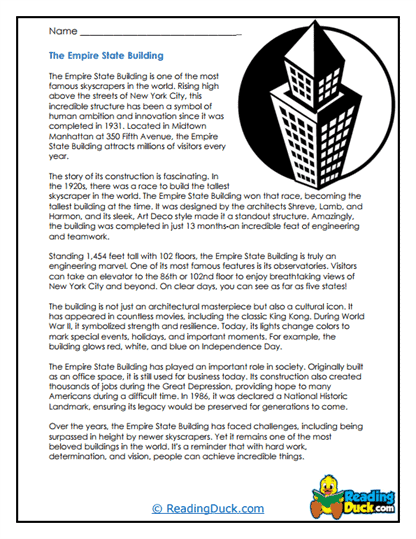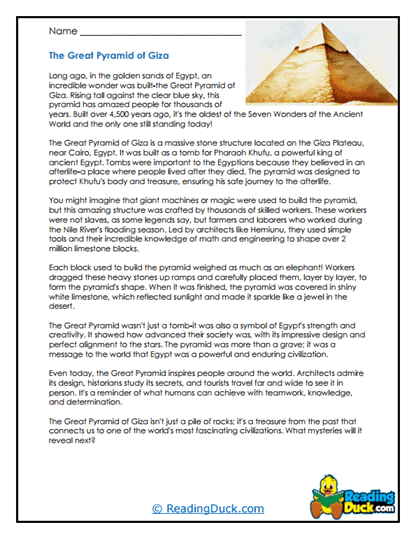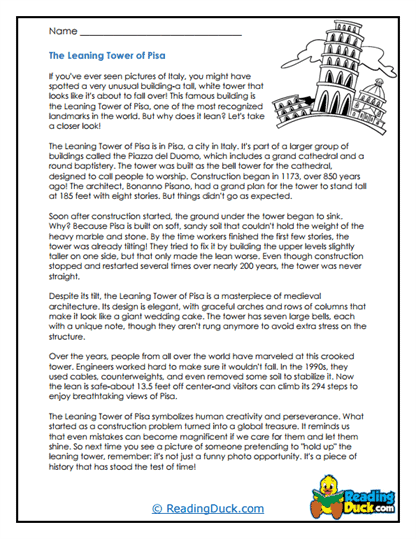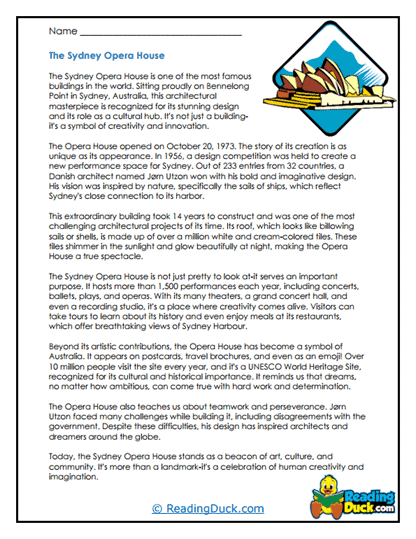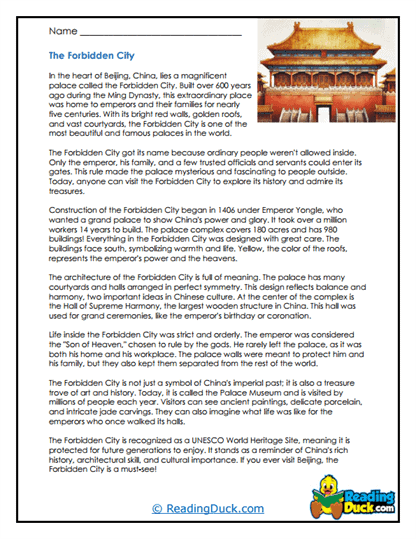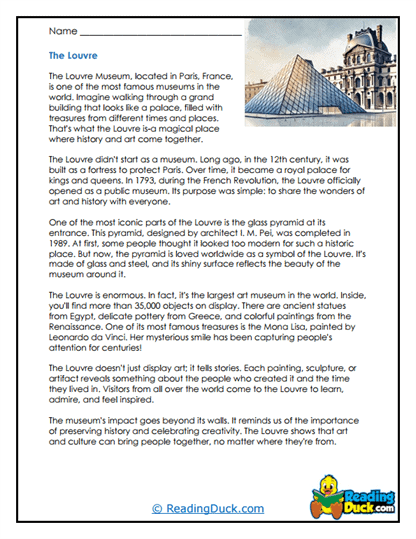Famous Buildings Worksheets
About Our Famous Buildings Worksheets
These reading worksheets combine reading comprehension with cultural and architectural exploration, offering students the opportunity to learn about famous landmarks in a structured and informative way. Whether you are a classroom teacher or a homeschool educator, these resources provide a unique way to inspire curiosity about world geography, history, and human achievement.
Each worksheet focuses on a specific building, such as the Eiffel Tower, the Taj Mahal, or the Great Wall of China. The content is carefully curated to include key details such as the building's location, historical context, construction methods, and cultural significance. For instance, students might learn how the Colosseum in Rome symbolized the architectural prowess of ancient Rome or how the Sydney Opera House reflects modern engineering and design. This allows students to build general knowledge while also practicing critical reading skills like identifying main ideas, understanding new vocabulary, and drawing inferences.
One of the great advantages of the worksheets is their adaptability across grade levels. For younger students, these worksheets can be designed with simple texts, colorful images, and basic comprehension questions, helping to develop foundational reading and critical thinking skills. For older students, the worksheets can include more detailed passages, research prompts, and opportunities for comparative analysis, encouraging higher-order thinking. Teachers can easily differentiate the content to suit the needs of individual learners, making these worksheets a flexible tool for mixed-ability classrooms or homeschool environments.
They are also excellent for integrating multiple subject areas into a single activity. While the primary focus is on reading comprehension, students are also exposed to topics in geography, world history, art, and even STEM. For example, a worksheet on the Burj Khalifa can inspire discussions about engineering marvels and advancements in skyscraper construction, while a lesson on the Pyramids of Giza can tie into ancient Egyptian culture and early human innovation. This interdisciplinary approach not only makes the learning process more holistic but also helps students make meaningful connections between subjects.
These worksheets can further be used as a springboard for creative projects and class discussions. After reading about a landmark, students can be encouraged to draw their own interpretations of the building, write reflective essays, or even build small models. Teachers and homeschoolers might also use the worksheets as part of larger thematic units on world cultures, travel, or architecture, thereby enriching the learning experience. Activities like these allow students to engage deeply with the material while encouraging creativity, teamwork, and personal expression.
By combining reading comprehension with lessons on geography, history, and architecture, these worksheets cultivate curiosity, critical thinking, and cultural awareness among students. Whether used as part of a classroom curriculum or within a homeschooling program, they are an effective way to inspire young learners to appreciate the remarkable structures that have shaped our world.
The Buildings That We Explore
Big Ben - Located in London, England, Big Ben refers to the iconic clock tower of the Palace of Westminster, officially known as Elizabeth Tower. Completed in 1859, it is renowned for its accuracy and the massive bell inside that chimes hourly. The 96-meter-tall Gothic Revival structure has become a global symbol of the United Kingdom.
Burj Khalifa - The Burj Khalifa, situated in Dubai, United Arab Emirates, is the tallest building in the world, standing at an astonishing 828 meters. Completed in 2010, it features residential spaces, offices, and observation decks offering breathtaking views of the city. This modern architectural marvel represents Dubai's rapid growth and innovation.
The Colosseum - The Colosseum, located in Rome, Italy, is an ancient amphitheater built around 70-80 AD under Emperor Vespasian. It was used for gladiatorial contests, public spectacles, and dramas, holding up to 50,000 spectators. This iconic symbol of Roman engineering remains a major tourist attraction and historical site.
The Eiffel Tower - The Eiffel Tower, in Paris, France, is a wrought-iron structure designed by Gustave Eiffel for the 1889 World’s Fair. Rising 330 meters high, it became a symbol of modern engineering and the most recognizable landmark of France. Initially controversial, it is now celebrated as a global icon of art and tourism.
The Empire State Building - Located in New York City, USA, the Empire State Building is a 102-story skyscraper completed in 1931 during the Great Depression. Standing 381 meters tall, it was the tallest building in the world for nearly 40 years. The Art Deco masterpiece is an enduring symbol of ambition and innovation in architecture.
The Forbidden City - The Forbidden City in Beijing, China, served as the imperial palace for 24 emperors of the Ming and Qing Dynasties from 1420 to 1912. Spanning 180 acres, it houses nearly 1,000 buildings with traditional Chinese architecture. Today, it is a UNESCO World Heritage site and home to the Palace Museum.
The Louvre - The Louvre, located in Paris, France, is the world’s largest art museum and a historic landmark. Originally a fortress and later a royal palace, it was transformed into a public museum in 1793. It houses iconic works like the Mona Lisa and attracts millions of visitors annually.
The Parthenon - The Parthenon, perched on the Acropolis in Athens, Greece, is a temple dedicated to the goddess Athena, built in the 5th century BC. It is a masterpiece of Doric architecture and symbolizes ancient Greek culture and democracy. Despite centuries of damage, it remains a powerful symbol of Western civilization.
The Great Pyramid of Giza - Located near Cairo, Egypt, the Great Pyramid of Giza is the oldest and largest of the three pyramids, built around 2580 BC for Pharaoh Khufu. As one of the Seven Wonders of the Ancient World, it stood as the tallest human-made structure for over 3,800 years. It continues to fascinate as a marvel of ancient engineering.
Sydney Opera House - The Sydney Opera House in Sydney, Australia, is an architectural masterpiece designed by Jørn Utzon and completed in 1973. Known for its sail-like design, it hosts world-class performances in opera, music, and theater. It is a UNESCO World Heritage site and a symbol of Australian creativity.
The Taj Mahal - The Taj Mahal, located in Agra, India, is a white marble mausoleum commissioned by Emperor Shah Jahan in 1632 as a tribute to his wife, Mumtaz Mahal. Combining Persian, Islamic, and Indian architectural styles, it is considered one of the most beautiful buildings in the world. This UNESCO World Heritage site symbolizes eternal love.
The Leaning Tower of Pisa - The Leaning Tower of Pisa in Pisa, Italy, is a freestanding bell tower known for its unintended tilt, caused by unstable foundation soil. Built between the 12th and 14th centuries, it stands 56 meters tall and has been stabilized to prevent further leaning. It is a beloved landmark and a symbol of architectural resilience.
